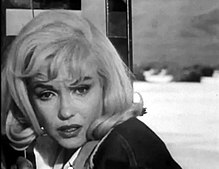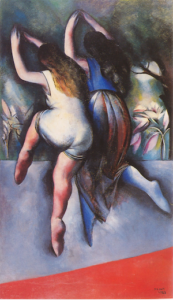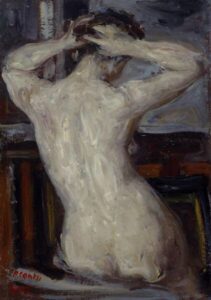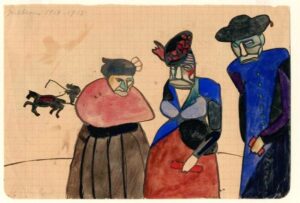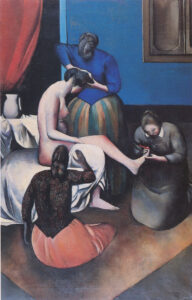Dear Zazie, Here is today’s Lovers’ Chronicle from Mac Tag dedicated to his muse. Have you been pierced by love? Has beauty been chased from your heart? Rhett
The Lovers’ Chronicle
Dear Muse,
© copyright 2020 mac tag/cowboy coleridge all rights reserved
© copyright 2019 mac tag/cowboy coleridge all rights reserved
turn this way and that,
hearts comin’ undone
chased away or lost,
forgot and abandoned
Picasso said…
Je ne cherche pas, je trouve
maybe that is the key
do not seek… find it
do not give up
do not settle
whatever it takes
however long it takes
find it
you are out there
and i will find you
© copyright 2017 mac tag/cowboy Coleridge all rights reserved
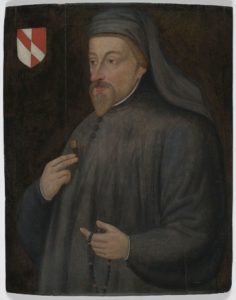 On this day, probably, in 1400 the great English poet Geoffrey Chaucer died in London. In 1366, Chaucer married Phillipa Pan, a “damsel of the queen’s bedchamber.” From his writin’s, one can find an invective against naggin’ and scoldin’ wives, so it seems that Chaucer’s married life was not particularly happy, that he was cynical about marriage and apparently in love with another woman. Our pal Jett says; “In other words, a typical marriage!”
On this day, probably, in 1400 the great English poet Geoffrey Chaucer died in London. In 1366, Chaucer married Phillipa Pan, a “damsel of the queen’s bedchamber.” From his writin’s, one can find an invective against naggin’ and scoldin’ wives, so it seems that Chaucer’s married life was not particularly happy, that he was cynical about marriage and apparently in love with another woman. Our pal Jett says; “In other words, a typical marriage!”
For today’s Poem of the Day, I offer my translation, from Middle English, of Chaucer’s “Merciless Beauty”:
Merciless Beauty
Your eyes pierce me suddenly
I may the beauty of them not sustain,
So wounds me and my heart keen
Unless your words heal hastily
My heart’s wound while that it grieves
Your eyes pierce me suddenly
Upon my troth I say to you faithfully,
You have been of my life and death the queen;
For with my death the truth shall be seen
Your eyes pierce me suddenly
I may the beauty of them not sustain,
So wounds me and my heart keen
So has your beauty from my heart chased
Pity, that it avails not to complain:
For fate holds your mercy in his chain
Guiltless my death have you purchased;
I say to you so, I need not feign:
So has your beauty from my heart chased
Alas, that nature has in you composed
So great beauty, that no man may attain
To mercy, though he starve for the pain
So has your beauty from your heart chased
Pity, that it avails not to complain
For fate holds your mercy in his chain
Since I from love escaped it yet,
I never plan to be in his prison;
Since I am free, I will not wait
He may answer and say this and that,
I care not, I speak right as I mean;
Since I from love escaped it yet
Love has my name struck from his slate,
And he is struck from my books clean:
For evermore, is my curse,
Since I from love escaped it yet
Your eyes pierce me suddenly
So has your beauty from my heart chased
Since I from love escaped it yet
The Song of the Day is Ralph Vaughan Williams‘ “So Hath Your Beauty”.

Today is the birthday of Richard Parkes Bonington (Arnold (near Nottingham) 25 October 1802 – 23 September 1828 London); Romantic landscape painter, who moved to France at the age of 14. He brought aspects of English style to France. Becoming after his very early death one of the most influential British artists of his time, the facility of his style was inspired by the old masters, yet was entirely modern in its application. His landscapes were mostly of coastal scenes, with a low horizon and large sky, showing a brilliant handling of light and atmosphere. He also painted small historical cabinet paintings in a freely-handled version of the troubadour style.
Gallery


-

Rouen
-

Normandy, c. 1823
-

View of the Lagoon Near Venice, 1827. Louvre
-

Venice, Grand Canal.
-

Charles V. visits François Ier after the Battle of Pavia, c. 1827
| Pablo Picasso | |
|---|---|

Picasso in 1908
|
|
Today is the birthday of Pablo Ruiz y Picasso, also known as Pablo Picasso (Málaga; 25 October 1881 – 8 April 1973 Mougins, France); painter, sculptor, printmaker, ceramicist, stage designer, poet and playwright. In my opinion, one of the greatest and most influential artists of the 20th century. He is known for co-founding the Cubist movement, the invention of constructed sculpture, the co-invention of collage, and for the wide variety of styles that he helped develop and explore. Among his most famous works are the proto-Cubist Les Demoiselles d’Avignon (1907), and Guernica (1937), a portrayal of the Bombing of Guernica by the German and Italian air forces at the behest of the Spanish nationalist government during the Spanish Civil War.
Exceptionally prolific throughout the course of his long life, Picasso achieved universal renown and fortune for his revolutionary artistic accomplishments, and became one of the best-known figures in 20th-century art.
In the summer of 1918, Picasso married Olga Khokhlova, a ballerina with Sergei Diaghilev’s troupe, for whom Picasso was designing a ballet, Erik Satie’s Parade, in Rome; they spent their honeymoon near Biarritz in the villa of glamorous Chilean art patron Eugenia Errázuriz. Khokhlova’s insistence on social propriety clashed with Picasso’s bohemian tendencies and the two lived in a state of constant conflict.
In 1927 Picasso met 17-year-old Marie-Thérèse Walter and began a secret affair with her. Picasso’s marriage to Khokhlova soon ended in separation rather than divorce, as French law required an even division of property in the case of divorce, and Picasso did not want Khokhlova to have half his wealth. The two remained legally married until Khokhlova’s death in 1955. Picasso carried on the affair with Walter and fathered a daughter with her, named Maya. Walter lived in the vain hope that Picasso would one day marry her, and hanged herself four years after Picasso’s death. Throughout his life Picasso maintained several mistresses in addition to his wife or primary partner. Photographer and painter Dora Maar was also a constant companion and lover of Picasso. The two were closest in the late 1930s and early 1940s, and it was Maar who documented the painting of Guernica.
In 1944, after the liberation of Paris, Picasso, then 63 years old, began a romantic relationship with a young art student named Françoise Gilot, who was 40 years younger than he was. In her 1964 book Life with Picasso, Gilot describes his abusive treatment and myriad infidelities which led her to leave him.
Picasso had affairs with women of an even greater age disparity than his and Gilot’s. While still involved with Gilot, in 1951 Picasso had a six-week affair with Geneviève Laporte, who was four years younger than Gilot. By his 70s, many paintings, ink drawings and prints have as their theme an old, grotesque dwarf as the doting lover of a beautiful young model. Jacqueline Roque (1927–1986) worked at the Madoura Pottery in Vallauris on the French Riviera, where Picasso made and painted ceramics. She became his lover, and then his second wife in 1961. The two were together for the remainder of Picasso’s life.
Picasso died on 8 April 1973 in Mougins, France, while he and his wife Jacqueline entertained friends for dinner. He was interred at the Chateau of Vauvenargues near Aix-en-Provence, a property he had acquired in 1958 and occupied with Jacqueline between 1959 and 1962. Devastated and lonely after the death of Picasso, Jacqueline Roque killed herself by gunshot in 1986 when she was 59 years old.
Gallery






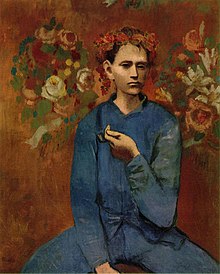
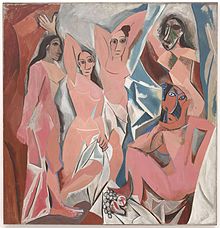
-

1909, Femme assise (Sitzende Frau), oil on canvas, 100 × 80 cm, Staatliche Museen, Neue Nationalgalerie, Berlin
-

1909–10, Figure dans un Fauteuil (Seated Nude, Femme nue assise), oil on canvas, 92.1 × 73 cm, Tate Modern, London.
-

1910, Woman with Mustard Pot (La Femme au pot de moutarde), oil on canvas, 73 × 60 cm, Gemeentemuseum, The Hague.
-

1910, Girl with a Mandolin (Fanny Tellier), oil on canvas, 100.3 × 73.6 cm, Museum of Modern Art, New York
-

1910, Portrait of Daniel-Henry Kahnweiler, The Art Institute of Chicago.
-
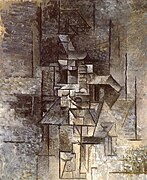
1910–11, Guitariste, La mandoliniste (Woman playing guitar or mandolin), oil on canvas
-

c.1911, Le Guitariste. Reproduced in Albert Gleizes and Jean Metzinger, Du “Cubisme”, 1912
-

1911, Still Life with a Bottle of Rum, oil on canvas, 61.3 × 50.5 cm, Metropolitan Museum of Art, New York
-

1911, The Poet (Le poète), oil on linen, 131.2 × 89.5 cm (51 5/8 × 35 1/4 in), The Solomon R. Guggenheim Foundation, Peggy Guggenheim Collection, Venice
-
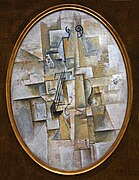
1911–12, Violon (Violin), oil on canvas, 100 × 73 cm (oval), Kröller-Müller Museum, Otterlo, Netherlands.
-
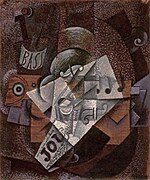
1913, Bouteille, clarinet, violon, journal, verre, 55 × 45 cm.
-
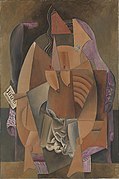
1913, Femme assise dans un fauteuil (Eva), Woman in a Chemise in an Armchair, oil on canvas, 149.9 × 99.4 cm, Leonard A. Lauder Cubist Collection, Metropolitan Museum of Art
-

1913–14, Head (Tête), cut and pasted colored paper, gouache and charcoal on paperboard, 43.5 × 33 cm, Scottish National Gallery of Modern Art, Edinburgh
-

1913–14, L’Homme aux cartes (Card Player), oil on canvas, 108 × 89.5 cm, Museum of Modern Art, New York
-

1914–15, Nature morte au compotier (Still Life with Compote and Glass), oil on canvas, 63.5 × 78.7 cm (25 × 31 in), Columbus Museum of Art, Ohio
-

1916, L’anis del mono (Bottle of Anis del Mono), oil on canvas, 46 × 54.6 cm, Detroit Institute of Arts, Michigan



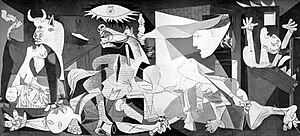
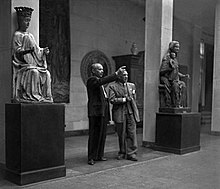
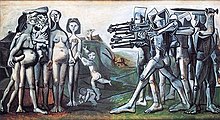
| Nils Dardel | |
|---|---|
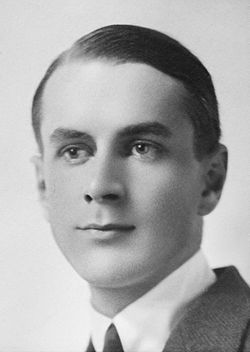
Nils Dardel in Tokyo 1917
|
|
Today is the birthday of Nils Dardel (Nils Elias Kristofer von Dardel, Bettna, Södermanland 25 October 1888 – 25 May 1943 New York City sometimes known as Nils de Dardel); Post-Impressionist painter, grandson to Swedish painter Fritz von Dardel.
In 1919 he proposed to Nita Wallenberg, but her father, a Swedish diplomat, disapproved of Dardel and the marriage was not to be.
Nils Dardel married the author Thora Dardel (1899–1995 – née Klinckowström), which lasted between 1921–1934.
After the marriage to Thora, sometime in the 1930s Nils meets Edita Morris (1902–1988, née Toll), a Swedish writer with whom he shares his remaining life.
Gallery
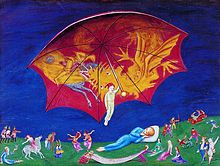

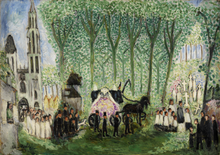




-

Self-portrait 1906
-

Gosshuvud 1908
-

Mansporträtt Portrait of a man 1908
-

Torparflicka Farm girl 1909
-
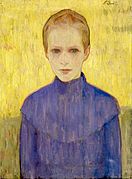
Flicka i blå klänning Girl in blue dress 1910
-

Två flickor Two Girls 1911
-

Turisthotellet i Rättvik Tourist hotel in Rättvik 1915
-

Den döende dandyn The Dying Dandy 1918
-

Den döende dandyn (1st version) 1918
-

Visit hos excentrisk dam 1921
-
Svarta Diana Black Diana 1929
-
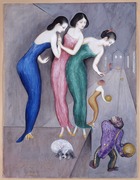
Drömmar och fanstasier #1 Dreams and fantasies 1922
-
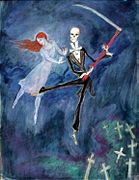
En dans med döden A dance with Death 1920
-

Familjeidyll Family idyll 1923
-

Return to the Playgrounds of Youth 1924
-

Marthe 1930
-

Ett hjärta i brand A heart in flames ca. 1930
-

Fiskaren The angler 1931
-

Gräshoppan The Grasshopper 1931
-
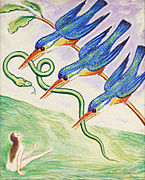
Den bortrövade ormen ca. 1931
-

Autoportrait 1935
-

Edita Morris 1936
-

Mexican boy ~1940
-

Mexican girl ~1940
-

Mexikansk kvinna med korslagda händer Mexican woman with crossed hands ~1940
-

Hustrumördaren The wife murderer ~1940
-

Mexican girl ~1940
-

Gammal mexikansk kvinna Old Mexican lady
-

Mexikansk Indian
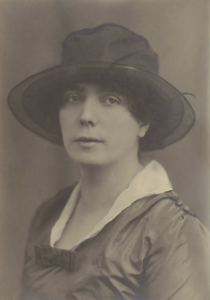 Writer James Joyce wrote to his wife Nora Barnacle, on 25 October 1909, “You are my only love. You have me completely in your power. I know and feel that if I am to write anything fine or noble in the future I shall do so only by listening to the doors of your heart. … I love you deeply and truly, Nora. … There is not a particle of my love that is not yours. … If you would only let me I would speak to you of everything in my mind but sometimes I fancy from your look that you would only be bored by me. Anyhow, Nora, I love you. I cannot live without you. I would like to give you everything that is mine, any knowledge I have (little as it is) any emotions I myself feel or have felt, any likes or dislikes I have, any hopes I have or remorse. I would like to go through life side by side with you, telling you more and more until we grew to be one being together until the hour should come for us to die. Even now the tears rush to my eyes and sobs choke my throat as I write this. Nora, we have only one short life in which to love. O my darling be only a little kinder to me, bear with me a little even if I am inconsiderate and unmanageable and believe me we will be happy together. Let me love you in my own way. Let me have your heart always close to mine to hear every throb of my life, every sorrow, every joy.”
Writer James Joyce wrote to his wife Nora Barnacle, on 25 October 1909, “You are my only love. You have me completely in your power. I know and feel that if I am to write anything fine or noble in the future I shall do so only by listening to the doors of your heart. … I love you deeply and truly, Nora. … There is not a particle of my love that is not yours. … If you would only let me I would speak to you of everything in my mind but sometimes I fancy from your look that you would only be bored by me. Anyhow, Nora, I love you. I cannot live without you. I would like to give you everything that is mine, any knowledge I have (little as it is) any emotions I myself feel or have felt, any likes or dislikes I have, any hopes I have or remorse. I would like to go through life side by side with you, telling you more and more until we grew to be one being together until the hour should come for us to die. Even now the tears rush to my eyes and sobs choke my throat as I write this. Nora, we have only one short life in which to love. O my darling be only a little kinder to me, bear with me a little even if I am inconsiderate and unmanageable and believe me we will be happy together. Let me love you in my own way. Let me have your heart always close to mine to hear every throb of my life, every sorrow, every joy.”
Mac Tag


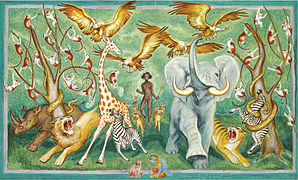
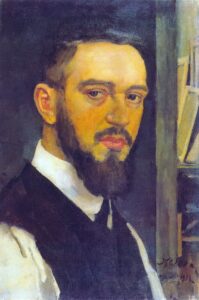 Today is the birthday of Konstantin Fyodorovich Yuon or Juon (Moscow October 24 [O.S. October 12] 1875 – April 11, 1958; Moscow); painter and theatre designer associated with the Mir Iskusstva. Later, he co-founded the Union of Russian Artists and the Association of Artists of Revolutionary Russia.
Today is the birthday of Konstantin Fyodorovich Yuon or Juon (Moscow October 24 [O.S. October 12] 1875 – April 11, 1958; Moscow); painter and theatre designer associated with the Mir Iskusstva. Later, he co-founded the Union of Russian Artists and the Association of Artists of Revolutionary Russia.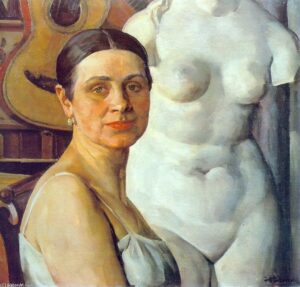
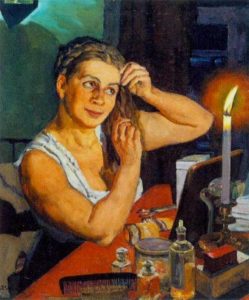


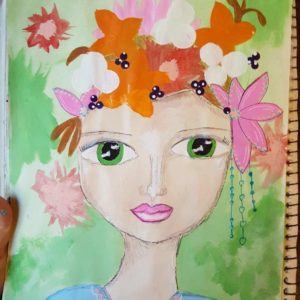 muse,
muse,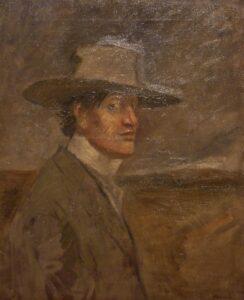 Today is the birthday of Jean-Louis Forain (Reims, France 23 October 1852 – 11 July 1931 Paris); Impressionist painter and printmaker, working in media including oils, watercolour, pastel, etching and lithograph.
Today is the birthday of Jean-Louis Forain (Reims, France 23 October 1852 – 11 July 1931 Paris); Impressionist painter and printmaker, working in media including oils, watercolour, pastel, etching and lithograph.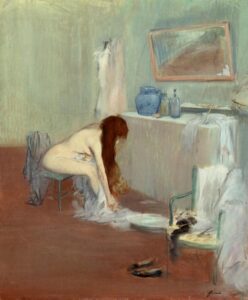
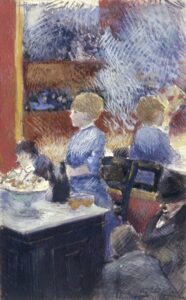
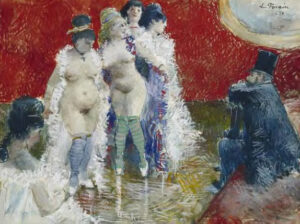
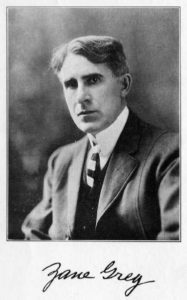 On this day in 1939, author Zane Grey died in Altadena, California. Grey married Dolly Roth, an apparently fine and forgivin’ woman. Durin’ his courtship of Dolly, Grey still saw previous girlfriends and warned her frankly, “But I love to be free. I cannot change my spots. The ordinary man is satisfied with a moderate income, a home, wife, children, and all that….But I am a million miles from being that kind of man and no amount of trying will ever do any good“. He added, “I shall never lose the spirit of my interest in women.” It was in Altadena that he spent time with his mistress Brenda Montenegro. The two met while hikin’ Eaton Canyon in California. Of her he wrote, “I saw her flowing raven mane against the rocks of the canyon. I have seen the red skin of the Navajo, and the olive of the Spaniards, but her…her skin looked as if her Creator had in that instant molded her just for me. I thought it was an apparition. She seemed to be the embodiment of the West I portray in my books, open and wild.” Just as I felt that you muse, had been molded for me.
On this day in 1939, author Zane Grey died in Altadena, California. Grey married Dolly Roth, an apparently fine and forgivin’ woman. Durin’ his courtship of Dolly, Grey still saw previous girlfriends and warned her frankly, “But I love to be free. I cannot change my spots. The ordinary man is satisfied with a moderate income, a home, wife, children, and all that….But I am a million miles from being that kind of man and no amount of trying will ever do any good“. He added, “I shall never lose the spirit of my interest in women.” It was in Altadena that he spent time with his mistress Brenda Montenegro. The two met while hikin’ Eaton Canyon in California. Of her he wrote, “I saw her flowing raven mane against the rocks of the canyon. I have seen the red skin of the Navajo, and the olive of the Spaniards, but her…her skin looked as if her Creator had in that instant molded her just for me. I thought it was an apparition. She seemed to be the embodiment of the West I portray in my books, open and wild.” Just as I felt that you muse, had been molded for me.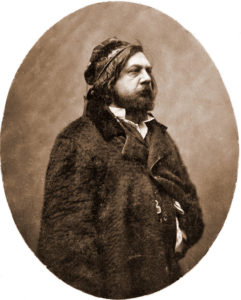 And on this day in 1872, French poet Théophile Gautier died in Paris. From TG we get the Poem of the Day which inspired me to write the lyrics of the day. To borrow from Shakespeare: Once more unto the dreams we go dear muse. And talk of phantoms as Halloween approaches. First the poem, then the lyrics:
And on this day in 1872, French poet Théophile Gautier died in Paris. From TG we get the Poem of the Day which inspired me to write the lyrics of the day. To borrow from Shakespeare: Once more unto the dreams we go dear muse. And talk of phantoms as Halloween approaches. First the poem, then the lyrics:

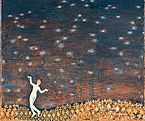







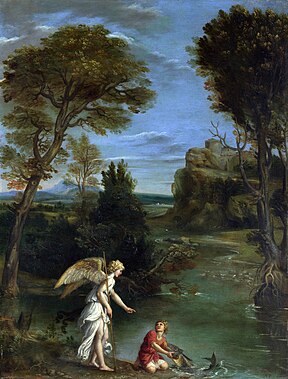





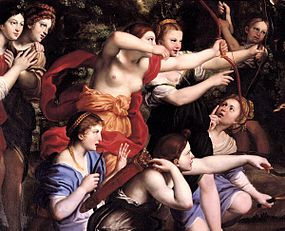







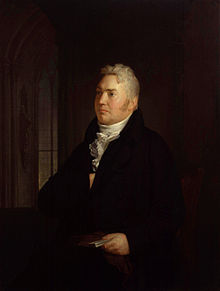


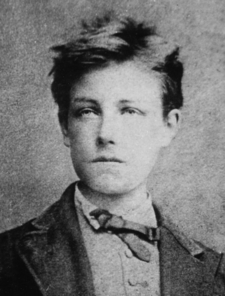




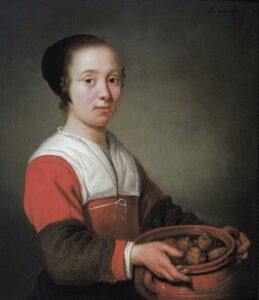






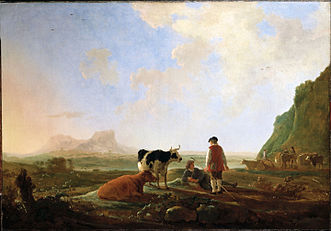






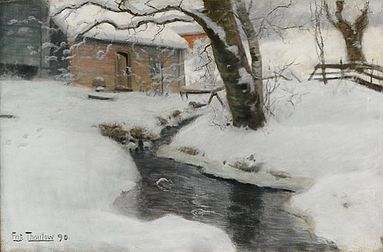


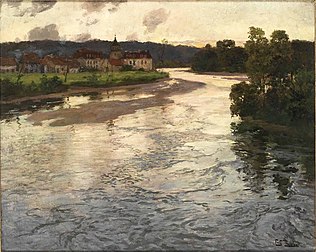



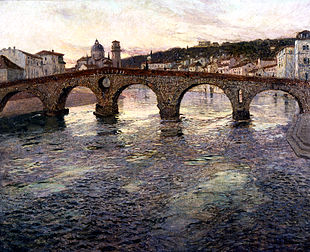
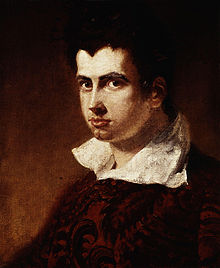



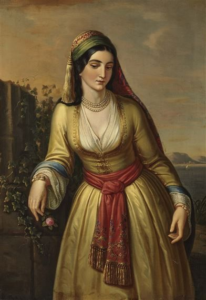






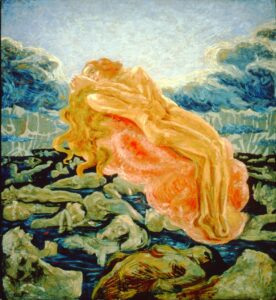
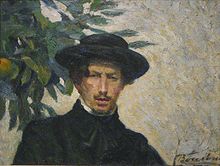










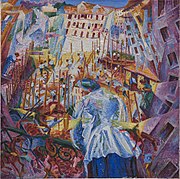
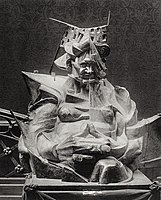
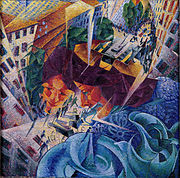





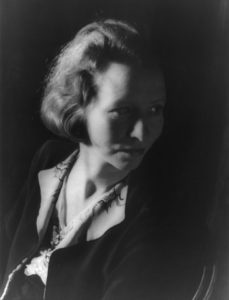 And on this day in 1950, poet Edna St. Vincent Millay died at her home, Steepltop, in Austerlitz, New York. In my opinion she wrote some of the best sonnets of the century. She was also well known for her affairs with both men and women. In 1923 she married Eugen Jan Boissevain (1880–1949), the widower of the labor lawyer and war correspondent Inez Milholland, a political icon Millay had met during her time at Vassar. Both Millay and Boissevain had other lovers throughout their twenty-six-year marriage. Millay’s most significant such relationship during this time was with the poet George Dillon for whom she wrote a number of her sonnets. Milly and Dillon collaborated on translations from Charles Baudelaire‘s Les Fleurs du Mal in 1936. Of course, the Poem of the Day is a Sonnet from Millay. It is typically called “Sonnet No. 2: Time does not bring relief; you all have lied.” I changed him/his to her and I call it:
And on this day in 1950, poet Edna St. Vincent Millay died at her home, Steepltop, in Austerlitz, New York. In my opinion she wrote some of the best sonnets of the century. She was also well known for her affairs with both men and women. In 1923 she married Eugen Jan Boissevain (1880–1949), the widower of the labor lawyer and war correspondent Inez Milholland, a political icon Millay had met during her time at Vassar. Both Millay and Boissevain had other lovers throughout their twenty-six-year marriage. Millay’s most significant such relationship during this time was with the poet George Dillon for whom she wrote a number of her sonnets. Milly and Dillon collaborated on translations from Charles Baudelaire‘s Les Fleurs du Mal in 1936. Of course, the Poem of the Day is a Sonnet from Millay. It is typically called “Sonnet No. 2: Time does not bring relief; you all have lied.” I changed him/his to her and I call it: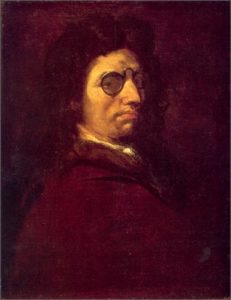 Today is the birthday of Luca Giordano (Naples 18 October 1634 – 12 January 1705 Naples); late Baroque painter and printmaker in etching. Fluent and decorative, he worked successfully in Naples and Rome, Florence and Venice, before spending a decade in Spain.
Today is the birthday of Luca Giordano (Naples 18 October 1634 – 12 January 1705 Naples); late Baroque painter and printmaker in etching. Fluent and decorative, he worked successfully in Naples and Rome, Florence and Venice, before spending a decade in Spain.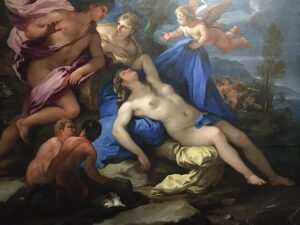


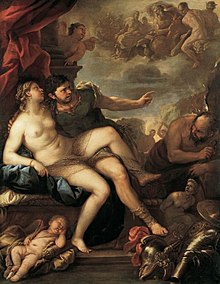
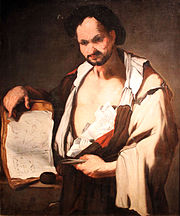

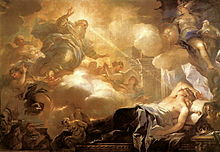
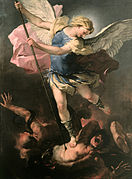


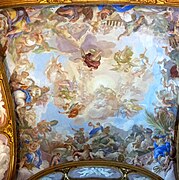




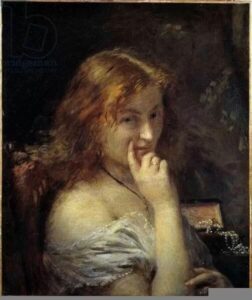


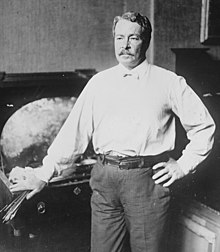


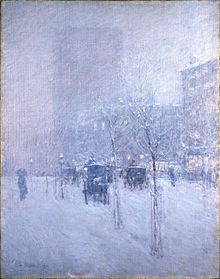
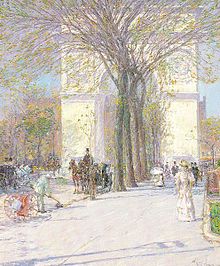

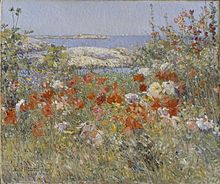






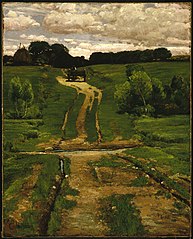
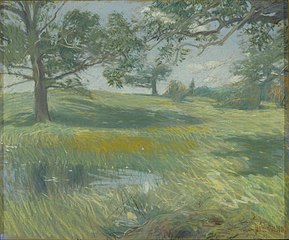






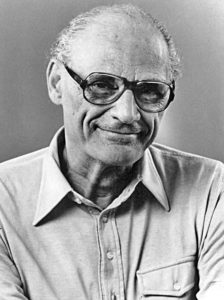 Today is the birthday of Arthur Miller (Arthur Asher Miller; Harlem; October 17, 1915 – February 10, 2005 Roxbury, Connecticut); playwright, essayist, and a major figure in the twentieth-century American theater. Among his most popular plays are All My Sons (1947), Death of a Salesman (1949), The Crucible (1953) and A View from the Bridge (1955, revised 1956). He also wrote several screenplays and was most noted for his work on The Misfits (1961).
Today is the birthday of Arthur Miller (Arthur Asher Miller; Harlem; October 17, 1915 – February 10, 2005 Roxbury, Connecticut); playwright, essayist, and a major figure in the twentieth-century American theater. Among his most popular plays are All My Sons (1947), Death of a Salesman (1949), The Crucible (1953) and A View from the Bridge (1955, revised 1956). He also wrote several screenplays and was most noted for his work on The Misfits (1961).

